Complete Solutions to Example of chapter SOLID STATE of Class 12 book with complete answers and questions
| Class 12 | CHEMISTRY |
| Chapter | SOLID STATE |
| DINESH COMPANION CHEMISTRY | Example |
| Number Of Questions | 63 |
| Academic Year | 2023-24 |
Identify the intermolecular forces that must be overcome to cause the melting of the following solids. Also arrange the solids in increasing order of melting points.
(a) NaF (b) HF (c) HCl (d) `Cl_(2)`04:25View SolutionIdentify the type of cyrstalline solid based on the following properties :
(a) Conducts electricity in the molten state but in the solid state.
(b) Very hard with melting point and acts as electrical insulator.
(c) Conducts electricity in the solid state, malleable and ductile.02:15View SolutionOut of Xe, `CH_(3)Cl` and HF which has :
(i) the smallest dipole-pole forces (ii) the largest hydrogen bond forces (c) the larges dispersion forces?04:43View SolutionA cubic solid is made up of two atoms A and B. Atoms A are present at the corners and B at the centre of the body.
What is the formula of the unit cell ?03:32View SolutionCalculate the number of atoms in a cubic based unit cell having one atome on each corner and two atoms on each body diagonal.
03:18View SolutionA unit cell consists of a cube in which there are A atoms at the corners and B atoms at the face centres. Two A atoms are missing from the two corners of the unit cell. What is the formula of the compound ?
04:24View SolutionIf three elements P, Q and R crystallise in a cubic unit cell with P atoms at the corners, Q atoms at the cubic centre and R atoms at the centre of each face of the cube, then write the formula of the compound.
04:03View SolutionAtoms A, B, C and D are present at corners, face centres, body centres and edge centres and respectively in a cubic unit cell. Find the formula of compound.
04:07View SolutionA mineral containing calcium, oxygen and titanius crystallises in a given cubic unit cell. What is the formula of the mineral?
02:41View SolutionA compound `M_(p)X_(q)` has cubic close packing `(ccp)` arrangement of `X`. Its unit cell structure is shown below. The empirical formula of the compound is
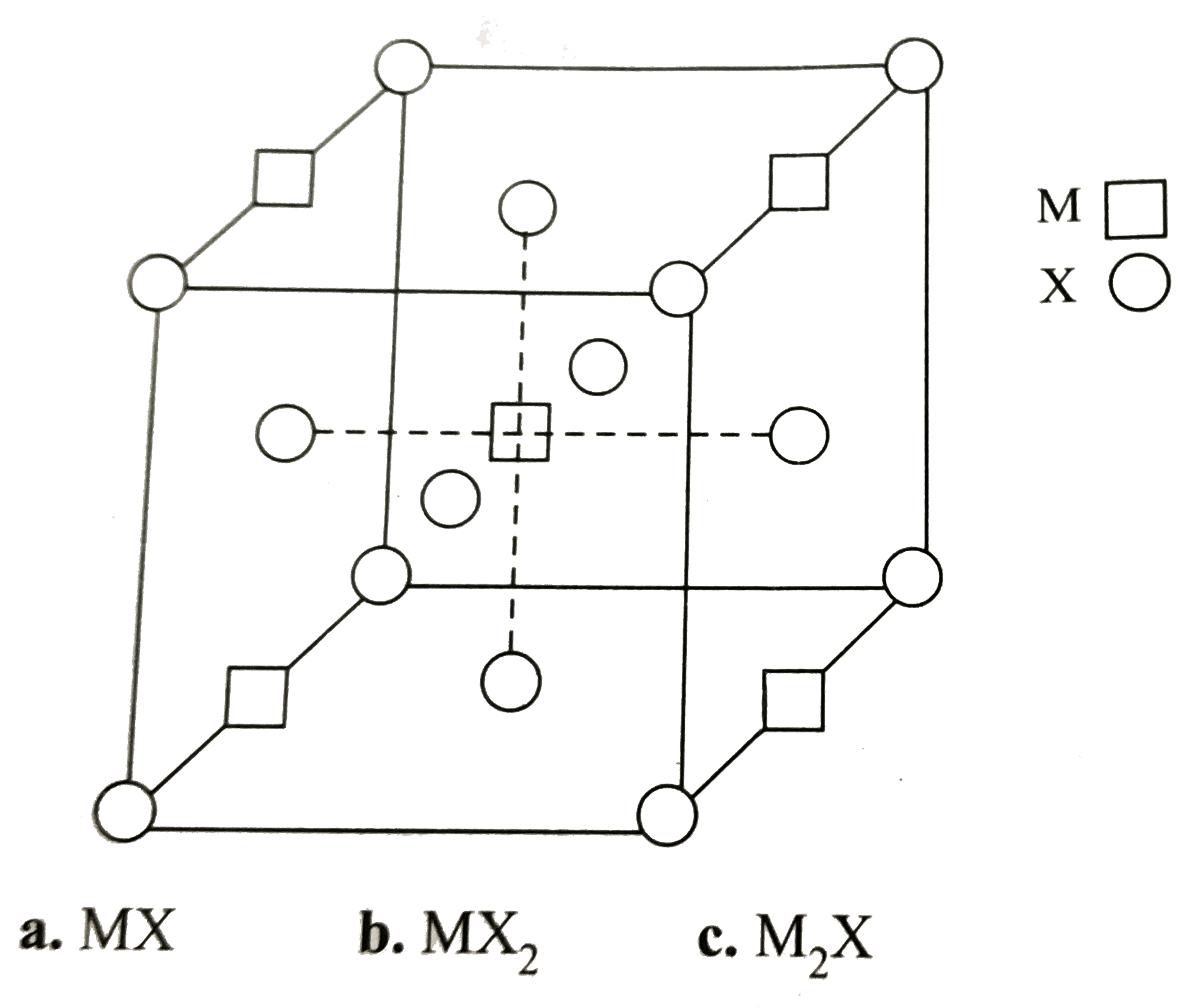 02:12View Solution
02:12View SolutionA compound is formed by two elements `X` and `Y`. Atoms of the element `Y` (as anion) make ccp and those of element `X` (as cation) occupy all the octahedral voids. What is the formula of the compound?
02:54View SolutionAtoms of elements `B` from hep lattice and those of element `A` occupy two-thirds of tetrahedral voids. What is the formula of the compound formed by elements `A` and `B`?
03:34View SolutionIn sapphire, oxide ions are arranged in hexagonal close packing and aluminium ions occupy two-thirds of the octahedral voids. What is the formula of sapphire?
01:58View SolutionA solid between `A` and `B` has the following arrangement of atoms `:`
`(i)` Atoms `A` are arranged in `c.c.p.` array.
`(ii)` Atoms `B` occupy all the all the octahedral voids and half the tetrahedral voids. What is the formula of the compound ?03:10View SolutionIn a cubic close packed structure (ccp) of mixed oxides, it is found that lattice has `O^(2-)` ions and one half of the octahedral voids are occupied by trivalent cations `(A^(3+))` and one-eighth of the tetrahedral voids are occupied by divalent cations `(B^(2+))`. Derive the formula of the mixed oxide.
03:00View SolutionPotassium crystallises in a bcc lattice as shown in figure :
(a) What is the distance the nearest neighbours ?
(b) What is the distance between the next nearest neighbours ?
(c) How many nearest neighbours does each potassium atom have ?
(d) How many next nearest neighbours does each potassium atom have ?
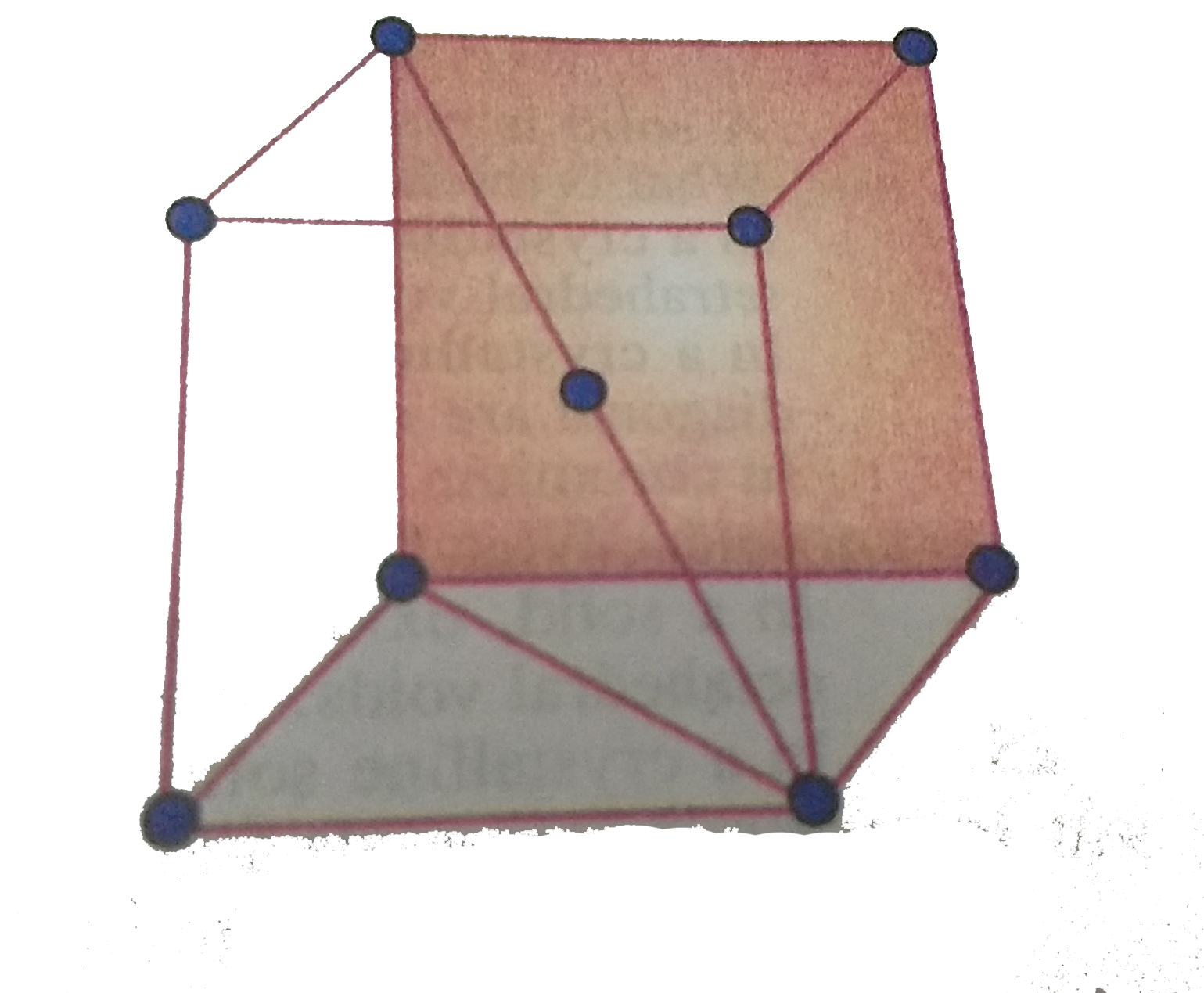 05:35View Solution
05:35View SolutionThe figure exhibits how to calculate the amount of space used by the atoms in a single cubic structure.
(a) What is the volume of the entire cube?
(b) What is the volume of one sphere?
(c) What fraction of any one sphere sticks into the cube rather than outside it?
(d) Given that there are eight spheres in all, how much space will they take up in the cube ?
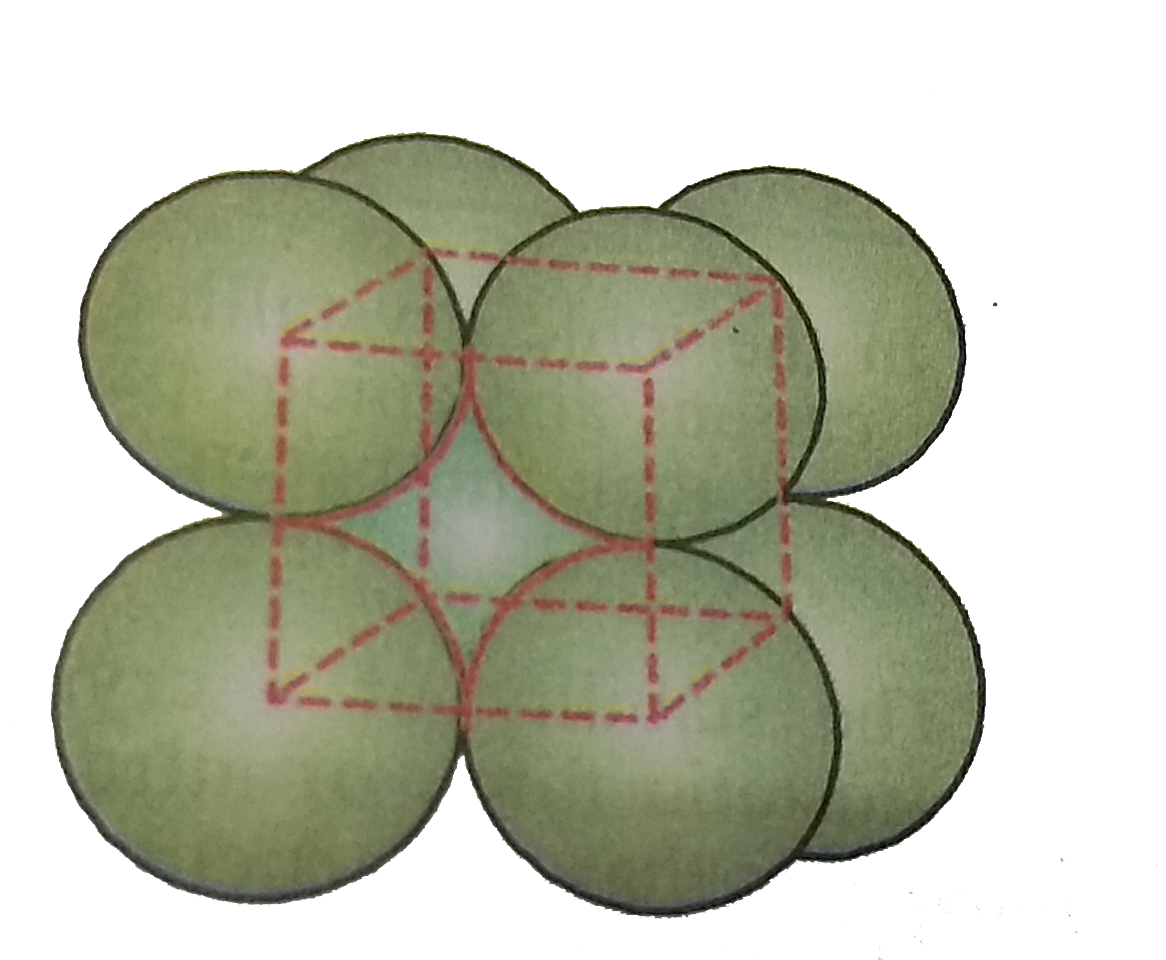 04:11View Solution
04:11View SolutionA metallic crystal cystallizes into a lattice containing a sequence of layers `ABABAB…`. Any packing of spheres leaves out voids in the lattice. What percentage by volume of this lattice is empty spece?
02:41View SolutionPredict the structure of MgO crystal and the co-ordination number of the cation in which the radii of the cation and anion are 65 pm and 140 pm respectively.
01:53View SolutionA solid `AB` has `NaCl` structure. If the radius of the cation `A` is `100` pm, what is the radius of anion `B`?
01:53View SolutionA solid `A^(o+)B^(ɵ)` has `NaCl`-type close-packed structure. If the anion has a radius of `250` pm, what should be the ideal radius for the cation? Can a cation `C^(o+)` having radius of `180` pm be slipped into the tetrahedral site of the crystal `A^(o+)B^(ɵ)`? Give reason for your answer.
03:40View SolutionThe unit cell edge length of NaF crystal is `4.634Å`. If the ionic radius of `Na^(+)` ion is 95 pm, what is the ionic radius of `F^(-)` ion, assuming that anion-anion contact and face centred cubic lattice?
01:53View SolutionThe radius of copper atom is 128 pm. It it crystallises in face centred cubic lattice (fcc), what will be the length the edge of the unit cell ?
02:14View SolutionSodium crystallises in a body-centred cubic unit cell. (bcc) with edge length `4.29Å`. What is the radius of the sodium atom ? What is the length of the body-diagonal of the unit cell?
02:16View SolutionWhen heated above `916^(@)C`, iron changes, its crystal structure from body centred cubic to cubic closed packed structure. Assuming that the metallic radius of an atom does not change, calculate the ratio of the density of the bcc crystal to that of ccp crystal.
02:22View SolutionSilver metal crystallises in a cubic closed- packed arrangement with the edge of the unit cell having a length, a = 407 pm. What is the radius of silver atom?
01:50View SolutionSilver crystallises in a face centred cubic unit cell. Each side of the unit cell has a length of 409 pm. What is the radius of an atom of silver? (Assume that each face centred atom is touching the four corner atoms.)
01:42View SolutionAluminium metal forms a cubic face centred closed packed crystal structure. Its atomic radius is `125xx10^(-12)`m.
(a) Calculate the length of the side of the unit cell.
(b) How many unit cells are there in `1.0m^(3)` of aluminium?03:11View SolutionSodium crystallises in b.c.c unit cell. Calculate the approximate number of unit cells in 9.2 g of solium (Atomic mass of Na = 23u).
02:44View SolutionAn element crystallises in `f.c.c.` lattice having edge length `400 p m`. Calculate the maximum diameter, which can be placed in interstitial sites without disturbing the structure.
05:47View SolutionSilver froms ccp lattice and `X`-ray studies of its crystals show that the edge length of its unit cell is `408.6` pm. Calculate the density of silver (atomic mass `= 107.9 u`).
03:37View SolutionA face-centred cubic element (atomic mass `60`) has a cell edge of `400` pm. What is its density?
02:25View SolutionThe edge length of NaCl unit cell is 564 pm. What is the density of NaCl in g/`cm^(3)`?
02:27View SolutionA metal crystallizes into two cubic phases, face-centred cubic and body-centred cubic, which have unit cell lengths `3.5` and `3.0 A`, respectively. Calculate the ration of densities of fcc and bcc.
03:44View SolutionCalculate the density of silver which crystallises in face-centred cubic from. The distance between nearest metal atoms is 287 pm (Molar mass of Ag = `107.87gmol^(-1),(N_(0)=6.022xx10^(23)mol^(-1))`.
02:45View SolutionGold (atomic mass = 197 u) has atomic radius = 0.144 nm. It crystallises in face centred unit cell. Calculate the density of gold. (No = `6.022xx10^(23)mol^(-1))`
02:17View SolutionAn element crystallises in a f.c.c. lattice with edge length of 400 pm. Calculate the density if 200 g of this element contain `2.5xx10^(24)` atoms.
04:13View SolutionAn element 'x' (Atomic mass = 40 g `mol^(-1)`) having f.c.c. structure has unit cell edge length of 400 pm. Calculate the density of 'x' and the number of unit cells in 4 g of 'x'
03:39View SolutionNiobium crystallises in body centred cubic structure. If the atomic radius is 143.1 pm, calculate the density of the element. (Atomic mass = 93 u)
02:25View SolutionAn element A crystallises in fcc structure. 200 g of this element has `4.12xx10^(24)` atoms. If the density of A is `7.2"g cm"^(-3)`, calculate the edge length of the unit cell.
04:48View SolutionWhat is the distance between `Na^(+)` and `Cl^(-)` ions in NaCl crystal if density is `2.165"g cm"^(-3)` ? NaCl crystallises in fcc lattice.
04:10View SolutionThe density of lead is 11.35 g `cm^(-3)` and the metal crystallises with fcc unit cell. Estimate radius of lead atom.
03:48View Solution`X`-rays diffraction studies show that copper crystallizes in an fcc unit cell with cell edge of `3.608 xx 10^(-8) cm`. In a separte experiment, copper is determined to have a density of `8.92 g cm^(3)`. Calculate the atomic mass of copper.
03:41View SolutionA element crystallises in a bcc structure. The edge length of its unit cell is 288 pm. If the density of the crystal is 7.3 g `cm^(-3)` , what is the atomic mass of the element ?
02:16View SolutionAn element with density `11.2"g cm"^(-3)` forms a fcc lattice with edge length of `4xx10^(-8)` cm. Calculate the atomic mass of the element.
02:12View SolutionAn element of atomic mass 40 occurs in fcc structure with a cell edge of 540 pm. Calculate the Avogadro's number if density is `1.7gm//cm^(3)`.
02:37View SolutionAn element has a bcc structure with a celledge of `288` pm. The density of the element is `7.2 g cm^(-3)`. How many atins are present in `208 g` of the element?
05:11View SolutionThe element chromium crystallises in a body centred cubic lattice whose density is `7.20g//cm^(3)`. The length of the edge of the unit cell is 288.4 pm. Calculate Avogadro's number (Atomic mas of Cr = 52).
02:21View SolutionCalculate the value of Avogadro's number from the following data:
Density of `NaCl = 2.165 g cm^(-3)`
Distance between `Na^(o+)` and `Cl^(Θ)` in `NaCl = 281` pm04:05View SolutionThe well know mineral flourite is chemically calcium fluoride. It is a well known fact that in one unit cell of this mineral, there are four `Ca^(2+)` ions and eight `F^(-)` ions and `Ca^(2+)` ions are arranged in f.c.c. lattice. The `F^(-)` ions fill all the tetrahedral holes in the face centred cubic lattice of `Ca^(2+)` ions. The edge length of the unit cell is `5.46xx10^(-8)` cm. The density of the solid is `3.18"g cm"^(-3)`. Use this information to calculate Avogadro's number (Molar mass of `CaF_(2)=78.0"g mol"^(-1)`)
04:15View SolutionThe density of KBr is `2.73"g cm"^(-3)`. The length of the unit cell is 654 pm. Predict the nature of the unit cell. (Given atomic mass of K = 39, Br = 80)
03:00View SolutionThe density of chormium is `7.2"g cm"^(-3)`. If the unit cell is a cube edge length of 298 pm, determine the type of the unit cell. (Atomic mass of Cr = 52 amu)
02:26View SolutionDensity of Li is `0.53"g cm"^(-3)`. The edge length of Li is `3.5Å`. Find the number of Li atoms in a unit cell `(N_(0)=06.023xx10^(23),M=6.94)`.
02:54View SolutionMethane crystallises in a cubic unit cell with a = 0.598 nm. Calculate the theoretical density of methane assuming Z = 1, 2 and 4. If the density of liquid methane is `0.466"g cm"^(-3)` and assume that density of solid is the same as that of the liquid at a given temperature, predict which type of unit cell result?
04:49View SolutionA element X with atomic mass 60 g/mol has a density of `6.23"g cm"^(-3)`. If the edge length of the unit cell is 400 pm, identify the type of the cubic unit cell. Calculate the radius of the atoms of the element.
03:29View SolutionDensity of copper metal is `8.95"g cm"^(-3)`. If the radius of copper atoms is `127.8"pm"` predict the nature of its unit cell whether simple cubic, faced centred or body centred cubic. (Given atomic mass of Cu = 63.54 g `mol^(-1)` and `N_(o)=6.022xx10^(23)mol^(-1)`)
03:53View SolutionConsider the figure of a defective crystal :
(a) Name the defect shown by this diagram.
(b) What is the effect of this defect on the solid ?
(c) Name as ionic compound which can show this type of defect.
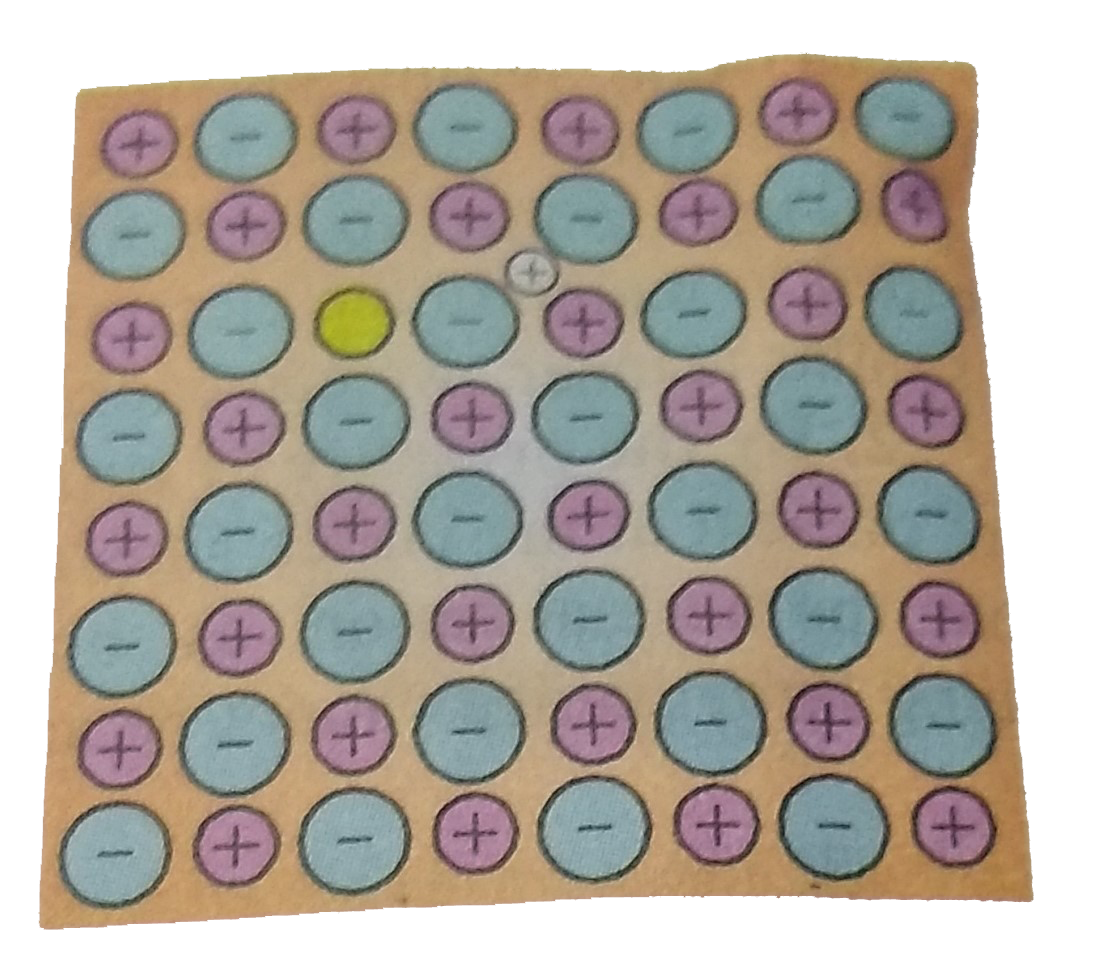 03:02View Solution
03:02View SolutionExamine the illustration of a portion of the deffective crystal and answer the following question :
(a) What are these type of vacancy defects called ?
(b) How is the density of a crystal affected by these defects ?
(c) Name one ionic compound which can show this type of defect in the crystalline state.
(d) How is the stoichiometry of the compound affected ?
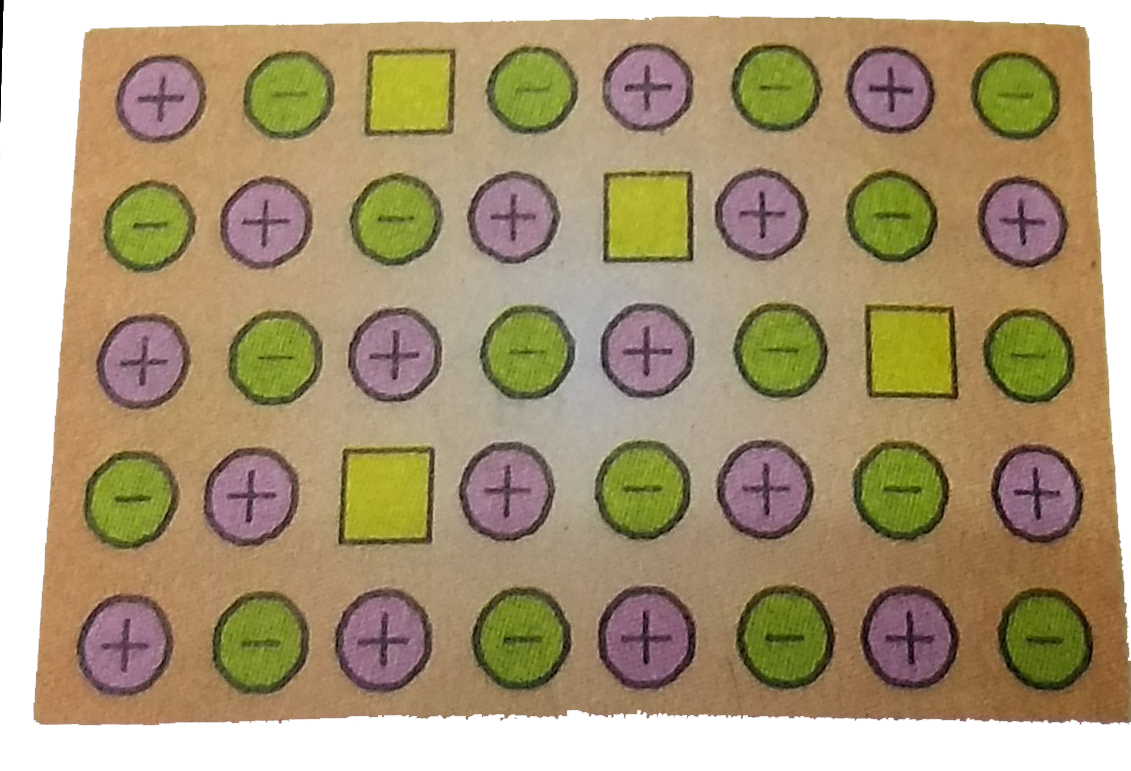 02:52View Solution
02:52View SolutionThe composition of a sample of Wustite is `Fe_(0.93)O_(1.00)`. What fraction of iron is present in the from of `Fe^(2+)` ion ?
03:35View SolutionAnalysis shows that a metal oxide has the empirical formula `M_(0.96)O_(1.00)`. Calculate the percentage of `M^(2+)` and `M^(3+)` ions in the sample.
04:07View SolutionThe first `-` order diffraction os `X-` rays from a certain set of crystal planes occurs an angle of `11.8^(@)` from the planes. If the planes are `0.281 nm` apart, what is the wavelength of `X-` rays?
01:35View SolutionCalculate the angle at which first order reflection will occur in an X-ray spectrometer when X-rays of wavelength `1.54Å` are diffracted by the atoms of a crystal given that interplanar distance is `0.04Å`.
02:03View SolutionWhat will be the wavelength of the X-rays which give a diffraction angle `2theta` equal to `16.80^(@)` for a crystal ? The interplanar distance in the crystal is `0.200` nm and only the diffraction of the first order is absorbed.
02:52View Solution
Example questions and complete solutions for chapter SOLID STATE of S DINESH & CO CHEMISTRY (HINGLISH) of Class 12
